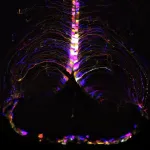(Press-News.org) Ebola is a deadly hemorrhagic disease caused by a virus that is endemic in parts of East-Central and West Africa. Most people are aware that a primary route for person-to-person transmission is through contact with bodily fluids from an infected person. But more recent outbreaks, including the 2013-2016 Ebola epidemic in West Africa, demonstrated that infectious Ebola virus (EBOV) is also found on the skin’s surface of those who have succumbed to infection or at late times during infection. Although evidence suggests that EBOV can be passed on from skin contact with a person in the later stages of the disease, very little is known about how the virus makes its way out of the body and onto the skin’s surface.
In a new study, researchers at University of Iowa Health Care and colleagues at Texas Biomedical Research Institute and Boston University, have traced a cellular route the virus uses to traverse the inner and outer layers of skin and emerge onto the skin’s surface. The study identifies new cell types within the skin that are targeted by EBOV during infection and shows that human skin specimens actively support EBOV infection. Overall, the findings, which were published Jan. 1 in Science Advances, suggest that the skin’s surface may be one route of person-to-person transmission.
“The skin is the largest organ in the human body yet is woefully understudied compared to most other organs. Interactions of EBOV with skin cells have not previously been extensively examined,” says Wendy Maury, PhD, UI professor of microbiology and immunology, and senior author of the study. “Our work provides evidence for one mechanistic avenue that EBOV uses to exit from the human body. A comprehensive understanding of which cells are targeted during virus infection is critical for rational development of antiviral approaches.”
Human skin model helps trace EBOV escape
The research team, led by Maury and Kelly Messingham, PhD, UI research professor of dermatology, developed a new approach to examine which cells within the skin are infected by Ebola virus.They created a human skin explant system using full-thickness skin biopsies from healthy individuals, which contained both deeper (dermal), and surface (epidermal) layers of skin.
To study how Ebola virus moves through skin, the explants were placed dermal side down in culture media and virus particles were added to the media so that they entered the skin from the underside, modeling virus egress from the blood to the surface of the skin. The researchers used virus-tracing and cell-tagging techniques to follow the journey of the virus through the skin layers to the upper surface of the skin, identifying which cells were infected over time.
Previous clinical and animal studies had reported that cells within the skin become infected with EBOV, but the specific cells targeted by the virus had not been identified.
In the new study, the team showed that EBOV infected several different cell types in the skin explant, including macrophages, endothelial cells, fibroblasts, and keratinocytes. While some of these cell types are also found to be infected by EBOV in other organs, keratinocytes, that are unique to the skin, had not been previously appreciated to support EBOV infection.
Interestingly, virus replication was more robust in the epidermal layer than the dermal layers on a per gram basis. Additionally, the infectious virus was detected on the epidermal surface within three days, indicating that the virus rapidly spreads and moves through the explants to the skin’s surface.
The researchers also showed that human skin explants can serve as complex, three- dimensional organ models for studying the efficacy of antivirals against EBOV, providing a new, highly useful, and inexpensive model system for therapeutic testing.
Finally, the team also focused on the interactions of EBOV with two specific skin cell types, fibroblasts and keratinocytes, and identified specific receptors on these cells that allow uptake of Ebola virus.
“This study explores the role of the skin as a potential route of Ebola virus infection and identifies, for the first time, several cell types in the skin that are permissive to infection,” says Messingham. “In total, these findings elucidate a mechanism by which EBOV traffics to the skin’s surface and may explain person-to-person transmission via skin contact.”
In addition to Messingham and Maury, the study team included UI researcher Paige Richards, Anthony Fleck, Radhika Patel, Jonah Elliff, Samuel Connell, Tyler Crowe, Juan Munoz Gonzalez, Francoise Gourronc, Jacob Dillard, and Aloysius Klingelhutz. MarijaDjurkovic and Olena Shtanko at Texas Biomedical Research Institute, and Robert Davey at Boston University were also part of the team.
The research was funded in part by grants from the National Institute of Allergy and Infectious Diseases.
END
University of Iowa study traces Ebola's route to the skin surface
Findings suggest skin contact may be one avenue for person-to-person transmission
2025-01-01
ELSE PRESS RELEASES FROM THIS DATE:
Study finds smoking linked to increased risk of chronic kidney disease in later stages
2025-01-01
A recent study published in Health Data Science led by Zhilong Zhang from the Institute of Medical Technology at Peking University Health Science Center and Professor Luxia Zhang from the National Institute of Health Data Science at Peking University has shed light on the complex relationship between smoking behavior and chronic kidney disease (CKD). Using data from over 500,000 participants in the UK Biobank cohort, the researchers conducted both traditional observational studies and advanced Mendelian randomization (MR) analyses to explore whether smoking behavior ...
System to auto-detect new variants will inform better response to future infectious disease outbreaks
2025-01-01
Researchers have come up with a new way to identify more infectious variants of viruses or bacteria that start spreading in humans - including those causing flu, COVID, whooping cough and tuberculosis.
The new approach uses samples from infected humans to allow real-time monitoring of pathogens circulating in human populations, and enable vaccine-evading bugs to be quickly and automatically identified. This could inform the development of vaccines that are more effective in preventing disease.
The approach can also quickly detect ...
Key players in brain aging: New research identifies age-related damage on a cellular level
2025-01-01
SEATTLE, WASH.—January 1, 2025—Scientists at the Allen Institute have identified specific cell types in the brain of mice that undergo major changes as they age, along with a specific hot spot where many of those changes occur. The discoveries, published in the journal Nature, could pave the way for future therapies to slow or manage the aging process in the brain.
Key findings
Sensitive cells: Scientists discovered dozens of specific cell types, mostly glial cells, known as brain support cells, that underwent significant gene expression changes with age. Those strongly affected included microglia and border-associated ...
Pupil size in sleep reveals how memories are sorted, preserved
2025-01-01
ITHACA, N.Y. – Cornell University researchers have found the pupil is key to understanding how, and when, the brain forms strong, long-lasting memories.
By studying mice equipped with brain electrodes and tiny eye-tracking cameras, the researchers determined that new memories are being replayed and consolidated when the pupil is contracted during a substage of non-REM sleep. When the pupil is dilated, the process repeats for older memories. The brain’s ability to separate these two substages of sleep with a previously unknown micro-structure is what ...
Revealing a key mechanism of rapid centromere evolution
2025-01-01
A joint research group team led by Sayuri Tsukahara and Tetsuji Kakutani of the University of Tokyo has clarified a mechanism of how retrotransposons, genetic elements that can “jump around” chromosomes and are known drivers of evolution, preferentially insert in the centromere. The findings were published in the journal Nature.
The centromere is the thinnest part of the chromosome that divides it into a long and short arm, much like how the waist separates the upper and lower body. Its role in transmitting information via cell division has been preserved ...
A tour de force: Columbia engineers discover new “all-optical” nanoscale sensors of force
2025-01-01
New York, NY—January 1, 2025—Mechanical force is an essential feature for many physical and biological processes. Remote measurement of mechanical signals with high sensitivity and spatial resolution is needed for a wide range of applications, from robotics to cellular biophysics and medicine and even to space travel. Nanoscale luminescent force sensors excel at measuring piconewton forces, while larger sensors have proven powerful in probing micronewton forces. However, large gaps remain in the force magnitudes that can be probed remotely from subsurface ...
Ancient DNA unlocks new understanding of migrations in the first millennium AD
2025-01-01
Francis Crick Institute press release
Under strict embargo: 16:00 GMT Wednesday 1 January 2025
Peer reviewed
Observational study
Ancient people
Ancient DNA unlocks new understanding of migrations in the first millennium AD
Waves of human migration across Europe during the first millennium AD have been revealed using a more precise method of analysing ancestry with ancient DNA, in research led by the Francis Crick Institute.
Researchers can bring together a picture of how people moved across the world by looking at changes in their DNA, but this becomes a lot harder when historical ...
MIT scientists pin down the origins of a fast radio burst
2025-01-01
Fast radio bursts are brief and brilliant explosions of radio waves emitted by extremely compact objects such as neutron stars and possibly black holes. These fleeting fireworks last for just a thousandth of a second and can carry an enormous amount of energy — enough to briefly outshine entire galaxies.
Since the first fast radio burst (FRB) was discovered in 2007, astronomers have detected thousands of FRBs, whose locations range from within our own galaxy to as far as 8 billion light-years away. Exactly how ...
Researchers reveal why the lung is a frequent site of cancer metastasis
2025-01-01
Leuven, 2 January 2024 – Researchers from the lab of Prof. Sarah-Maria Fendt (VIB-KU Leuven) and colleagues have uncovered that the availability of the amino acid aspartate is one reason why the lung is a frequent organ of metastasis. Their work appears in Nature and improves our understanding of cancer biology while providing the foundation for new therapeutic interventions in metastatic diseases.
A role for aspartate
More than half of cancer patients in whom the cancer spreads beyond the primary site have lung metastases. What makes the lungs such a ...
Aging may change some brain cells more than others
2025-01-01
EMBARGOED FOR RELEASE: Jan. 1, 2025, 11 a.m. ET
CONTACT:
NIAPressTeam@mail.nih.gov, 301-496-1752
Aging may change some brain cells more than others
NIH-funded mouse study provides roadmap for how aging may alter brain cell genetic activity
Based on new brain mapping research funded by the National Institutes of Health (NIH), scientists have discovered that not all cell types in the brain age in the same way. They found that some cells, such as a small group of hormone-controlling cells, may undergo more age-related changes in genetic activity than others. The results, published ...
LAST 30 PRESS RELEASES:
This new understanding of T cell receptors may improve cancer immunotherapies
A new fossil face sheds light on early migrations of ancient human ancestor
A new immunotherapy approach could work for many types of cancer
A new way to diagnose deadly lung infections and save lives
40 percent of MRI signals do not correspond to actual brain activity
How brain-inspired algorithms could drive down AI energy costs
Gum disease may be linked to plaque buildup in arteries, higher risk of major CVD events
Contrails are a major driver of aviation’s climate impact
Structure of dopamine-releasing neurons relates to the type of circuits they form for smell-processing
Reducing social isolation protects the brain in later life
Keeping the heart healthy increases longevity even after cancer
Young adults commonly mix cannabis with nicotine and tobacco
Comprehensive review illuminates tau protein's dual nature in brain health, disease, and emerging psychiatric connections
Book prepares K-12 leaders for the next public health crisis
Storms in the Southern Ocean mitigates global warming
Seals on the move: Research reveals key data for offshore development and international ecology
Sports injuries sustained during your period might be more severe
World's first successful 2 Tbit/s free-space optical communication using small optical terminals mountable on satellites and HAPS
Can intimate relationships affect your heart? New study says ‘yes’
Scalable and healable gradient textiles for multi‑scenario radiative cooling via bicomponent blow spinning
Research shows informed traders never let a good climate crisis go to waste
Intelligent XGBoost framework enhances asphalt pavement skid resistance assessment
Dual-function biomaterials for postoperative osteosarcoma: Tumor suppression and bone regeneration
New framework reveals where transport emissions concentrate in Singapore
NTP-enhanced lattice oxygen activation in Ce-Co catalysts for low-temperature soot combustion
Synergistic interface engineering in Cu-Zn-Ce catalysts for efficient CO2 hydrogenation to methanol
COVID-19 leaves a lasting mark on the human brain
Scientists use ultrasound to soften and treat cancer tumors without damaging healthy tissue
Community swimming program for Black youth boosts skills, sense of belonging, study finds
Specific depressive symptoms in midlife linked to increased dementia risk
[Press-News.org] University of Iowa study traces Ebola's route to the skin surfaceFindings suggest skin contact may be one avenue for person-to-person transmission




